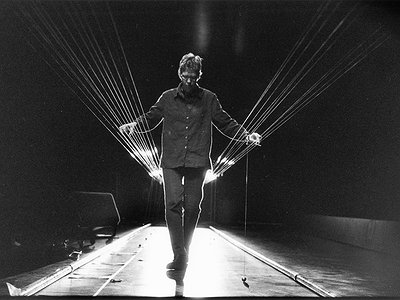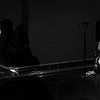Name: Ellen Fullman
Nationality: American
Occupation: Composer
Recommendations: “The World of Yesterday” by Stefan Zweig; “The Vasulka Effect”, a documentary film on Steina and Woody Vasulka, produced by Sagafilm & Krumma Films
If you enjoyed this interview with Ellen Fullman and would like to find out more about her, her excellent personal website should be your first destination.
When did you start writing/producing music - and what or who were your early passions and influences? What is it about music and/or sound that drew you to it?
Ever since I was a child, I have been drawn to listening in detail when I heard unusual timbre in music. I first began creating sound pieces for performance art in 1979, recording my voice and found objects with an open reel tape recorder and simple processing such as changing the playback speed or backwards playback. In 1980 I took a course on extended recording studio techniques where I learned about tape loops and editing with a blade and editing block. I decided to cover the erase head with a small piece of aluminium. This interfered with full erasure, and produced a residue of overprinted chorusing when I recorded a vocal loop many times over itself. Whenever something sounds like it is supposed to, I have lost interest, what holds me is the sound of invention. The work that I was excited about at this time was Steve Reich’s “Come Out” , Tony Conrad’s “Outside the Dream Syndicate”, Laurie Anderson and Talking Heads.
For most artists, originality is first preceded by a phase of learning and, often, emulating others. What was this like for you? How would you describe your own development as an artist and the transition towards your own voice? What is the relationship between copying, learning and your own creativity?
My father was an artist and by age five I decided that I was going to become an artist. This desire and commitment never wavered.
I grew up in Memphis, and as a teenager I was drawn to the haunted downtown streets where so much history had taken place in the meshing of cultures that became rock and roll. I listened to archival records and sang along to try to reproduce the uniquely African American melodic ornamentations that I find so moving. At age 14 I began taking classes in ceramics and continued to pursue this as my major in art school. I was most fascinated by Japanese Tea Ceremony forms and textures, and the motion frozen in time of liquid clay and glaze. I also appreciated the irony embodied in these objects, intentionally misshapen, raw and rough in execution and made by philosophic sophisticates in homage to rustic peasant pottery.
In art school I made thousands of drawings on the subject of space, Alberto Giacometti was a major influence. My drawing teacher, painter Stanley Lewis, once said that his own best works were nearly destroyed in the process of defining form through repeated mark making. I decided to take the “push and pull” theory of Hans Hofmann literally in creating my “Metal Skirt Sound Sculpture.” I had just discovered the Judson Church Group and the post-modern dance practice of appropriating everyday actions into performance. I turned myself into a mechanical marionette figure, where the simple act of walking produced the sound of simultaneous rising and falling glissandi through pushing and pulling strings attached to my shoes and the edge of the skirt construction.
When I was 23, Alvin Lucier’s “Music on a Long Thin Wire” inspired me to experiment with long strings when an accidental discovery revealed the sound of longitudinal vibration. Upon hearing Pauline Oliveros’s “Accordion and Voice”, I wanted to find a way to tune my strings so that I could play chords. I moved to New York City where I sought out engineering help and was able to begin to develop the LSI. When I was 36 I began to study North Indian vocal technique with Anita Slawek in Austin Texas for four years. Taught by oral tradition, the teacher sings a phrase and the student repeats. The process had a hypnotic effect on me where my mind let go and learning took place on another level. Gradually over time, the phrases become longer and longer. This practice increased my sensitivity to tone and intonation. If done properly, classical North Indian music is a lifelong full-time pursuit, but I wasn’t interested in following in a tradition. This work culminated in my album of songs, “Ort”, in collaboration with Konrad Sprenger. I have recently gone back to singing the exercises I learned from Anita and discovered that the work I did with her so many years ago has had a permanent effect on my body and I have been able to recover my voice.
Deborah Hay, the choreographer, has been a major influence on my sensibility and working methods. She says, “My body is my teacher.” I say, “My instrument is my teacher.” I think it is important to learn from what other artists have done but every artist at a certain point must turn inward and listen for their own unique purpose.
What were your main compositional- and production-challenges in the beginning and how have they changed over time?
Finding affordable large spaces to work in has been precarious, especially in the early days, and there were years that I didn’t have space to work in. This was the major reason I left New York City. In Austin a real estate developer gave me an unfinished floor of an office building to work in for four years. Booking gigs is also complicated, there have been invitations that I had to turn down. On the other hand, this project has brought me to work in many amazing grand scale spaces.
Looking for studio space is still daunting for me. To produce my current project, a composition for myself to play with the duo, The Living Earth Show, I will need to find an industrial space to rent for at least three months that is 2,000-3,000 square feet (600-900 square meters) to accommodate the larger number of strings and longer length strings that I want to use in my composition. The San Francisco Bay Area is one of the most expensive real estate markets in the U.S., so this will be a challenge.
Tell me about the Long String Instrument, please. How would you describe your relationship with it? What are its most important qualities and how do they influence the musical results – and possibly even your own performance?
I have been developing the Long String Instrument, an installation of dozens of wires fifty feet or more in length, tuned in Just Intonation, and played with rosin coated fingers, since the early 1980s. The Long String Instrument has functioned as my personal music school, leading me to study musical acoustics, Just Intonation tuning theory, instrument building, and to develop a compositional practice centered on string harmonics.
The Long String Instrument consists of wooden box resonators mounted at one end, with twenty to thirty strings terminating at each resonator box. Strings extend to another fixed point across the room. The fundamental pitch of each string is tuned via a custom-designed capo placed at a specific point along the string. When strings are excited in the longitudinal mode, enormous lengths are required and gauge has no effect on string length. For this reason I work with the same gauge wire. Bronze wire produces a tone about an interval of a fourth lower at the same length as steel wire and has a warmer timbre. I use steel wire for the higher range tunings because it has a purer clear tone.
To explain the length requirement: the pitch A4 (440 Hz), which on a grand piano is 8-9 feet long (about 2 ½ meters) (and vibrates in the transverse mode), on the Long String Instrument requires a capo stopping the string at about twenty-seven feet (or about 8 meters) from the resonator box. For a string on the Long String Instrument to sound at the fundamental pitch of A3 (220 Hz), one octave lower than A4, a string would have to be stopped with a capo about fifty-four feet (16 meters) from the resonator box.
All strings, including the ones on my instrument, vibrate in multiple modes at once, sounding the fundamental tone of the full length of the string as well as the tones or harmonics of segmented divisions of that length. Dampening a string at one of these divisions, or nodal points, isolates and reinforces that harmonic, so that it is more audible. On traditional string instruments, musicians play harmonics and other pitches by stopping the string across the fingerboard. While all of the strings of the Long String Instrument are the same length, the use of capos stops the effective vibrating length of each string, setting a different fundamental pitch for each string.
A performer with rosined fingers bows the instrument by rubbing along the length of the string, rather than bowing or strumming across the strings as in most traditional string instruments, thus setting the longitudinal vibration mode in motion. Since the pattern of overtone locations is proportioned to each string’s length, as the performer bows multiple strings lengthwise, the upper partial tones of these unfold at different rates, sounding like interlocked geared wheels of different sizes rotating. Even with pure simple harmony, the filtering my instrument imparts is a complex matrix of extended partials.
Playing my instrument is like walking or swimming in a strong current. If the harmony changes too drastically it is like going against the current – there is chaos and resistance from the power of what has been set in motion – the string really doesn’t want to speak.
With these forces at play, it is tempting to compose works that could extend infinitely in the same tonality. In my composition I seek ways to create movement. One strategy for composing modulations that I employ is listening for secondary harmonies in the upper partial tones with which to move a tonality to a new zone. Interestingly, such a transition on my instrument occurs not only in time, but also in space, since specific harmonics emerge at specific locations along the string length. I locate zones that I wish to preserve along my walking path and map these with my tablature notation, referencing numbers that are placed under the strings at metric intervals.
I have always sought to innovate my instrument’s design to optimize tone, emphasize lower frequencies and increase clarity in the harmonics. Through the years I have commissioned instrument builders to make prototypes, but it has become necessary for me to learn the process myself, in order to more deeply pursue my ideas. To quote Harry Partch, “I am a composer seduced into carpentry”. With a formal background in sculpture, I came to woodworking with a level of confidence in building things. In recent years I have been intensely engaged in woodworking for several months at a time working on resonator design. I am exploring tone woods: tapping, carving, and tuning plates made of rosewood, ebony and spruce. My resonators are designed to be modular. The soundboards and back plates are interchangeable and removable, sliding in through an unglued dado joint in the frame and coupled through string tension. Through changing out soundboards and back plates combined with different frames I am able to test differences in tone quality.
The results I am getting now thrill me and are opening new possibilities in composition that I have always envisioned. Through my compositions, and by refining my performance technique and the instrument design, I wish to reveal and share the beauty that I discover in the naturally occurring extended partials of vibrating strings.



